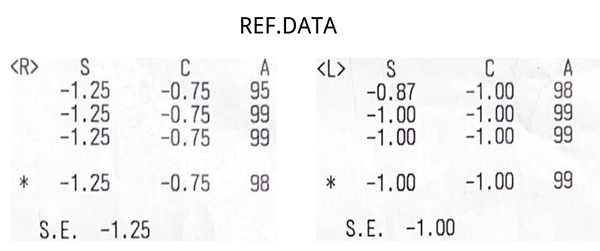How to read the printing data of the autorefractor?

- S: Sphere (SPH) measurement, this indicates the amount of nearsightedness or farsightedness in the eye. A negative value (e.g. -2.50) indicates nearsightedness, while a positive value (e.g. +1.25) indicates farsightedness.
- C: Cylinder (CYL) measurement, this indicates the amount of astigmatism in the eye. A cylinder value of zero means there is no astigmatism, while a positive or negative value (e.g. +0.75 or -1.25) indicates the amount of astigmatism.
- A: Axis measurement, this indicates the orientation of the astigmatism. It is measured in degrees, ranging from 0 to 180 degrees.
The corneal curvature, also known as K-reading or K-value, measures the curvature of the cornea, which is the clear outermost layer of the eye. This measurement is important in determining the proper fit of contact lenses or for diagnosing certain eye conditions such as keratoconus.
When an autofractor measures the corneal curvature, it will typically print out the following information:

- MM1: This measures the curvature of the cornea in the flattest meridian. It is usually also labeled as "K1" or "Flat K" on the printout.
- MM2: This measures the curvature of the cornea in the steepest meridian. It is usually also labeled as "K2" or "Steep K" on the printout.
- MM: This is the average of the flat and steep M-readings and is used to determine the overall curvature of the cornea.
- A: Axis measurement, this indicates the orientation of the corneal curvature and is measured in degrees, ranging from 0 to 180 degrees.
- R1: Data of the cornea in the flattest meridian.
- R2: Data of the cornea in the steepest meridian.
Corneal dioptric power is another measurement that can be obtained from an auto-refractor. This measurement is used to calculate the prescription for contact lenses or for assessing the cornea's refractive power.
Corneal astigmatism: This is the difference between the flat and steep K-readings and represents the amount of astigmatism present in the cornea.
Pupil distance (PD) measurement: This indicates the distance between the pupils of the eyes. It is measured in millimeters.
Corneal dioptric power is typically measured in diopters (D) and represents the amount of refractive power present in the cornea. The corneal dioptric power can be obtained by converting the corneal curvature readings (K-readings) into diopters.

